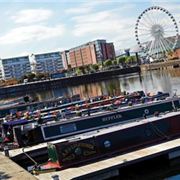ONE of Liverpool’s best known office complexes – the Customs and Excise Building at Queens Dock – is to be transformed into the city’s biggest “council house”.
Following the exit of hundreds of VAT collectors and civil servants, the now vacant, five-storey building which cantilevers over the water space, is destined to be converted into a gated estate - managed by a registered social landlord.
The proposals, which go before the council’s planning committee on Tuesday, will – if approved – will see the huge building switched from a purpose built office complex into 240 flats - 86 one-bedroomed , 124 two-bed and 20 three bedroom flats.
Bootle
There will also be a resident’s community centre, picnic area and children’s play area within the fenced estate which enjoys some of the best river views along Liverpool’s historic waterfront.
The Queens Dock building was constructed in the early 1990s by the Merseyside Development Corporation to facilitate relocation of the Government’s Custom and Excise’s VAT offices. It brought 1,800 Civil Service jobs from London. The tax office closed last year when the lease expired, with staff switched to Regian House in James Street and the Triad Building in Bootle.
The applicant for the new scheme is Glenbrook QD Limited, a property management company working with Mapeley, the company awarded the contract to dispose of hundreds of government buildings. This has resulted in a sizeable office.
The application states the housing scheme will be managed by a registered social landlord. Although it is not yet known which one that might be, there are several in the city including Plus Dane and Liverpool Mutual Homes. They now own and manage Liverpool's entire stock of council properties.
It could also address the widespread shortage of one and two-bedroom social properties in the city.
While there is pressure to attract government jobs to places like Liverpool, it raises the question of why a purpose built complex of almost 200,000 sq ft of office space is being sacrificed.
Disconnected
Planning officers in a report to Tuesday’s meeting explain the reason. They say the building is 1.2 km from the city’s main office area, being left entirely inactive on an extremely prominent part of Liverpool’s waterfront.
 New revenue: A residents' community centre, picnic area and the laughter of children where once rang out only tax demands
New revenue: A residents' community centre, picnic area and the laughter of children where once rang out only tax demands
“This disconnection from the city’s commercial quarter, the availability of other vacant office premises in more central locations and the lack of demand for such a quantum of office accommodation in the current economic climate, has severely limited its prospect of being re-used, in its entirety, for offices,” they say.
The area is zoned for mixed use and the proposed residential scheme will breathe new life into a vast empty building.
Brownfield
“This mix of high-quality accommodation that meets lifetime homes standards in a prestigious waterfront location is a highly attractive proposal that will assist in providing a balanced residential community in the city centre.
“The lease commitment by the third party operator demonstrates a long-term sustainable commitment to the building re-use. The proposal offers a viable and efficient re-use of an urban brownfield site, which is complimentary (sic) to neighbouring land uses, including the residential areas of Mariners Wharf, to the south, and the mixed-use leisure-led redevelopment of Kings Dock to the north.
"Indeed, the increased residential population in this area will also have knock-on spending benefits for local businesses and the city economy,” adds the report.
Reclaimed from the river

The site was reclaimed from the River Mersey during the construction of Liverpool’s extensive South Docks system, which commenced in 1788.
This site originally comprised a shipbuilding yard, but remodelling and enlargement of the docks to accommodate larger ships, resulted in the construction of Queens Graving Dock east-west across its centre.
In the 1980s and 1990s, the Merseyside Development Corporation (MDC) began a programme of work that involved the infilling of redundant dock basins, including King’s Dock (Nos. 1 & 2) and Queen’s Branch Dock No.2 immediately to the north.















